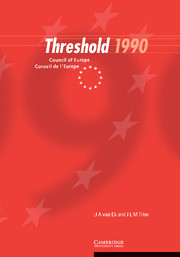Book contents
- Frontmatter
- Contents
- Preface
- Introduction
- 1 The objective: levels of specificity
- 2 The objective: general characterisation
- 3 The objective: extended characterisation
- 4 The objective: components of the specification
- 5 Language functions
- 6 General notions
- 7 Specific notions
- 8 Verbal exchange patterns
- 9 Dealing with texts: reading and listening
- 10 Writing
- 11 Sociocultural competence
- 12 Compensation strategies
- 13 Learning to learn
- 14 Degree of skill
- APPENDICES
14 - Degree of skill
Published online by Cambridge University Press: 26 February 2010
- Frontmatter
- Contents
- Preface
- Introduction
- 1 The objective: levels of specificity
- 2 The objective: general characterisation
- 3 The objective: extended characterisation
- 4 The objective: components of the specification
- 5 Language functions
- 6 General notions
- 7 Specific notions
- 8 Verbal exchange patterns
- 9 Dealing with texts: reading and listening
- 10 Writing
- 11 Sociocultural competence
- 12 Compensation strategies
- 13 Learning to learn
- 14 Degree of skill
- APPENDICES
Summary
So far, in the present study, we have been concerned with what learners might have to be able to do in the foreign language in order to satisfy their needs and interests. What we have not dealt with is how they should be able to do all the things specified. We have – it is true – listed many exponents (language forms) and strategies that, together, might enable the learners to function economically and effectively in the situations they are most likely to find themselves in. However, the exponents have been offered merely by way of recommendation and the strategies have mostly been described in an open-ended manner.
All this is tantamount to saying that the level we have described is not uniform and fixed but that it allows of many different concretisations in accordance with the diversity of sub-groups and individual members of the target population. Consequently, it is not in itself either a testing syllabus or a course design. However, its high degree of explicitness allows it to be used as a basis for these. A test syllabus designer will then have to determine the exact nature of the concretisations that correspond to the purposes of the text envisaged and thus establish the criteria the learners will have to satisfy in order to pass the test.
Threshold Level 1990, then, is simply a learning objective, an aim to be pursued with and by the learners and which is specified in such a way that it can give meaningful direction to the planning of learning activities.
- Type
- Chapter
- Information
- Threshold 1990 , pp. 112 - 114Publisher: Cambridge University PressPrint publication year: 1998

